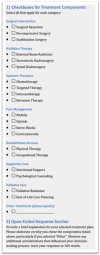ChatGPT's Performance in Spinal Metastasis Cases-Can We Discuss Our Complex Cases with ChatGPT?
- PMID: 39768787
- PMCID: PMC11727723
- DOI: 10.3390/jcm13247864
ChatGPT's Performance in Spinal Metastasis Cases-Can We Discuss Our Complex Cases with ChatGPT?
Abstract
Background: The integration of artificial intelligence (AI), particularly large language models (LLMs) like ChatGPT-4, is transforming healthcare. ChatGPT's potential to assist in decision-making for complex cases, such as spinal metastasis treatment, is promising but widely untested. Especially in cancer patients who develop spinal metastases, precise and personalized treatment is essential. This study examines ChatGPT-4's performance in treatment planning for spinal metastasis cases compared to experienced spine surgeons. Materials and Methods: Five spine metastasis cases were randomly selected from recent literature. Consequently, five spine surgeons and ChatGPT-4 were tasked with providing treatment recommendations for each case in a standardized manner. Responses were analyzed for frequency distribution, agreement, and subjective rater opinions. Results: ChatGPT's treatment recommendations aligned with the majority of human raters in 73% of treatment choices, with moderate to substantial agreement on systemic therapy, pain management, and supportive care. However, ChatGPT's recommendations tended towards generalized statements, with raters noting its generalized answers. Agreement among raters improved in sensitivity analyses excluding ChatGPT, particularly for controversial areas like surgical intervention and palliative care. Conclusions: ChatGPT shows potential in aligning with experienced surgeons on certain treatment aspects of spinal metastasis. However, its generalized approach highlights limitations, suggesting that training with specific clinical guidelines could potentially enhance its utility in complex case management. Further studies are necessary to refine AI applications in personalized healthcare decision-making.
Keywords: ChatGPT; decision making; spinal metastasis; spine; spine surgery.
Conflict of interest statement
The authors declare no conflict of interest.
Figures










References
LinkOut - more resources
Full Text Sources

